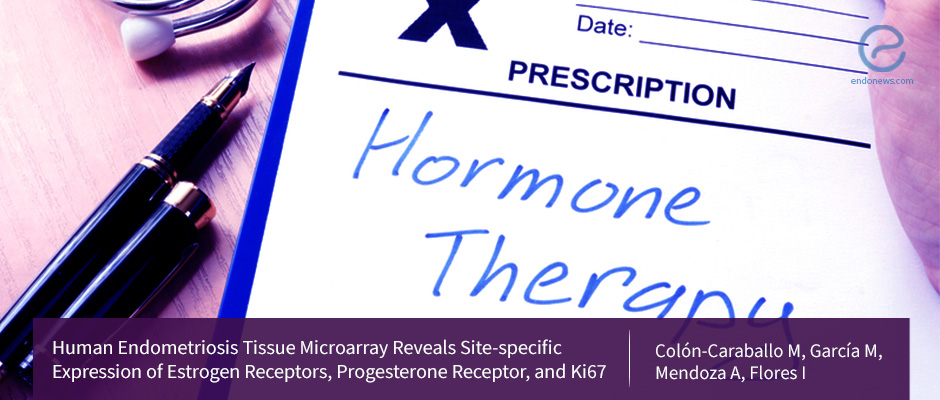Will my Endometriosis Respond to Hormone Therapy?
Jun 7, 2018
A new study suggests that it might be possible to predict individual responses to hormone therapy.
Key Points
Highlights
- Hormone receptors are found at different levels according to each woman and the type of endometrial lesion
Importance:
- Endometriosis is an estrogen-dependent and progesterone resistant lesion and steroid hormones play role in the establishment and maintenance of endometriotic lesions.
- However, hormone-based therapies for endometriosis do not take into consideration the hormone receptor status of individual patients.
- Characterizing the hormone receptor status of each woman could help predict how well they will respond to hormone treatment.
What's done here:
Researchers analyzed the expression pattern of estrogen and progesterone receptors, as well as markers of proliferation in the endometrium and endometrial lesions of women with and without endometriosis using a tissue microarray.
Key results:
- Ovarian lesions showed the lowest expression of estrogen receptor alpha and progesterone receptor and the highest expression of estrogen receptor beta.
- The fallopian tube lesions showed high expression of all three receptors.
- The stroma of proliferative endometrium from patients showed lower expression of estrogen receptor alpha and higher expression of estrogen receptor beta, compared to controls.
- The proliferative endometrium from patients showed a trend towards a loss of nuclear progesterone receptor
- The largest ratio of estrogen receptor beta versus alpha was observed in ovarian lesions and secretory endometrium.
- The highest proportion of samples with more than 10 percent Ki67 positive nuclei (a marker of cell proliferation) was seen in glands of the fallopian tube and extra-pelvic lesions
- 60 percent of glands of secretory endometrium from patients had more than 10 percent Ki67 positivity. This ratio was only 15 percent in controls.
Limitations:
More research is needed to confirm the relationship between hormone receptor status and response to treatment.
Lay Summary
Every woman has a different set of hormone receptors in the lining of their uterus. Yet, hormone-based therapies that are used to treat women with endometriosis do not take into consideration these differences among patients.
Analyzing, which particular hormone receptors are present in different individuals with endometriosis before hormone treatment is started, could predict their likelihood to respond to treatment and pave the way for personalized medicine approaches in the future.
In order to characterize the pattern of hormone receptors present in the lining of the uterus and different types of endometrial lesions, a team of researchers led by Dr.Idhaliz Flores at Ponte Health Sciences University in Puerto Rico analyzed different types of endometriotic lesions and normal endometrium from women with and without endometriosis.
They specifically looked at receptors for hormones such as estrogen alpha, estrogen beta, and progesterone. They also assessed the proliferative state of the tissues, or whether the cells were actively multiplying.
They first compared the amount of these receptors in different lesions and found that ovarian lesions had the lowest amount of estrogen alpha and progesterone receptors, and the highest amount of estrogen beta receptors. In contrast, lesions found in the fallopian tubes, the tubes that connect the ovaries to the uterus and through which eggs travel, had high amounts of all three hormone receptors.
The researchers also found that the tissue on which the lining of the uterus rests produced less estrogen alpha and more estrogen beta receptor in the proliferative phase in patients with endometriosis compared to those without. The proliferative phase is the phase of the menstrual cycle when the cells of the endometrium are multiplying and the tissue is growing under the influence of estrogen. In addition, the proliferative endometrium from endometriosis patients produced less progesterone receptor.
The biggest difference between estrogen alpha and estrogen beta receptors was seen in ovarian lesions and in the endometrium in the secretory phase, or phase of the menstrual cycle when the lining of the uterus attains its full maturity under the influence of progesterone and gets ready to receive a fertilized egg.
The highest level of proliferating, or multiplying cells was seen in the glands of the fallopian tubes and lesions outside the pelvic area. In the secretory phase, more than half of the endometrial glands were proliferating in patients, while only 15 percent of the glands were proliferating in control women.
“Our results provide a better understanding of endometriosis heterogeneity by revealing lesion type-specific differences and case-by-case variability in the expression of ovarian hormone receptors,” the researchers wrote. And they added: “This knowledge could potentially predict individual responses to hormone therapies, and set the basis for the application of personalized medicine approaches for women with endometriosis”.
The study was published in the Journal of Applied Immunohistochemistry & Molecular Morphology.
Research Source: https://www.ncbi.nlm.nih.gov/pubmed/29629944
Hormone receptors personalized medicine hormone therapy tissue microarray progesterone estrogen personalized medicine

